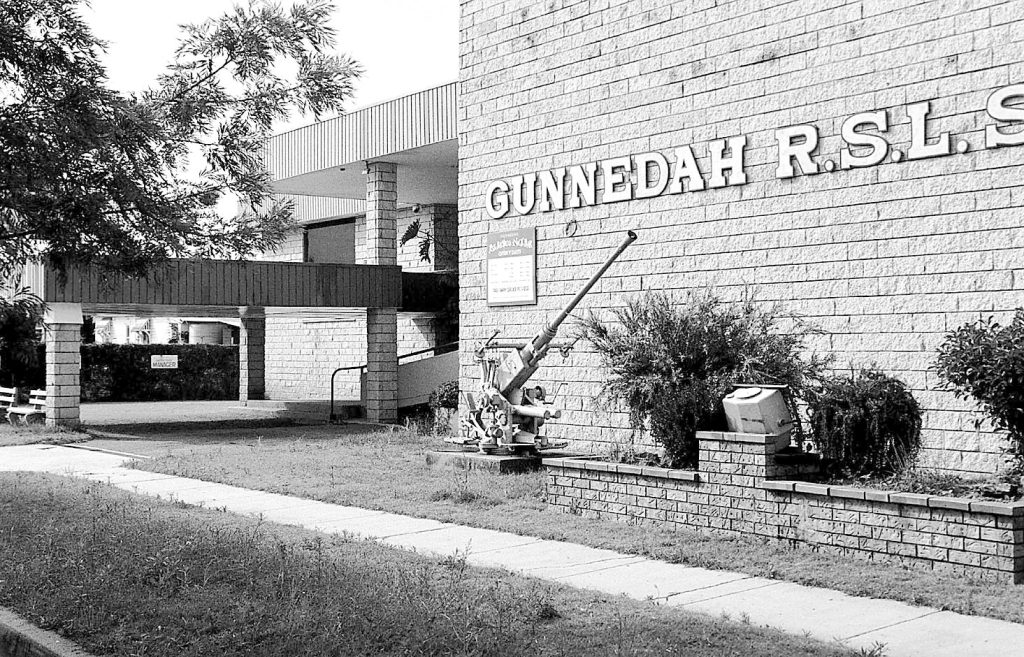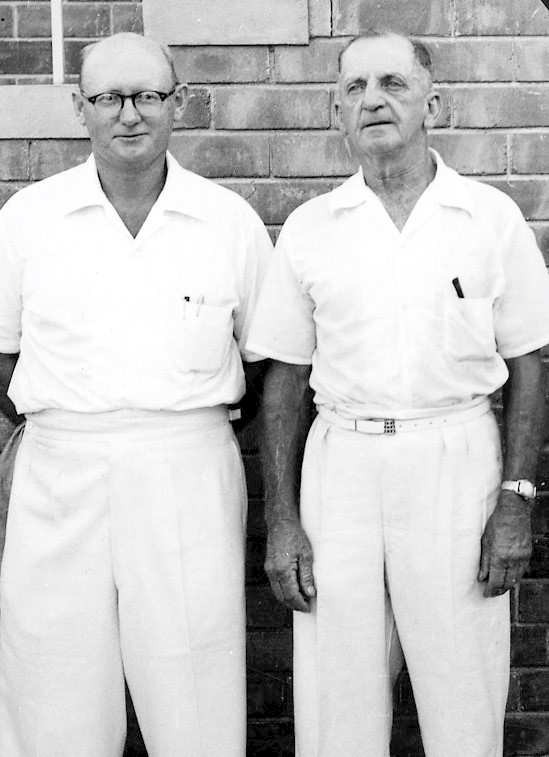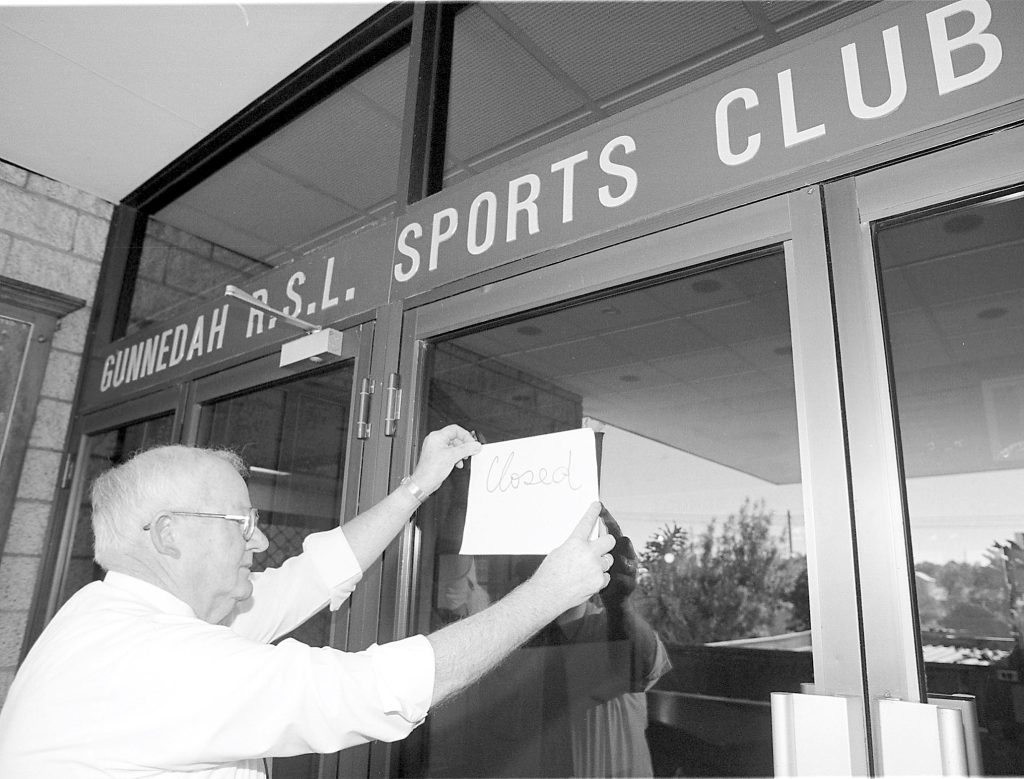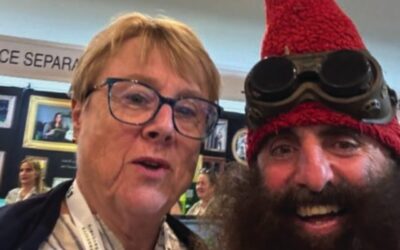Gunnedah RSL Bowling Club, which later became Gunnedah RSL Sports Club has disappeared from sight and memories since its shock closure in July 1999.
One of the largest licensed premises in the north west, the club had fought a running battle for survival for many years but the decision to close caught most people by surprise. The club had been unable to substantially reduce its debt on major extensions carried out in the mid-1970s and other factors included the downturn of the local economy, falling membership and reduced patronage, with the introduction of poker machines in hotels a few years earlier having drastically affected revenue.
It was a bitter pill, however, for older members of the RSL who had established the facility as a bowling club, in the 1950s.
Officially opened on April 7, 1956, by Sir George Holland, Federal President of the RSL, the RSL Club was constructed on one of the town’s most historic sites, the corner of Marquis and Little Conadilly Streets, where people of the Anglican faith had constructed Gunnedah’s first church in 1864. The building became the parish hall when the new church was built in 1903.
The RSL Sub-branch had purchased the Marquis Street site in 1951 and the following year a meeting agreed to press ahead with the formation of an RSL Bowling Club. The old Anglican Church hall was renovated as the first clubhouse and soil for the bowling green was carted to the site. In the early 1950s, the hall was used by RSL Sub-branch enthusiasts for fund-raising efforts through “housie” nights. Money raised was injected into a $1.25 million investment in buildings and bowling greens. The green was constructed by returned servicemen under the supervision of Bill Marshall (Tamworth) and when it was completed, Bill Bridges was appointed the first greenkeeper. The first roll-up took place on January 31, 1955, but soon after the 1955 flood swept over the green and the foundations that had been laid for the new clubhouse. In 1956, lights were installed on the green.

World War II veteran, Dick Smith, was a dedicated member of the Gunnedah RSL Bowling Club, serving many years as vice-president and looking after the greens. Another war veteran, Don Smyth, was also a dedicated foundation member, serving on the committee for 25 years. He was awarded life membership of the RSL Sports Club and the RSL Sub-branch. He served 17 years as welfare officer of the sub-branch and in 1974 received the NSW RSL certificate of appreciation.
Local builder Errol (Chum) Barton served in the RAAF and after the war was heavily involved in the RSL Bowling Club. He was a founding member in the 1950s and drew up plans for extensions and for the second bowling green. He was a good bowler, too, twice winning the club singles championship in the early 1960s and the prestigious Easter singles. He served 15 years as a director. His wife Heather was also prominent in bowls, as a foundation member of Gunnedah RSL Women’s Bowling Club and served on the committee for 20 years from 1961, including three years as president. She was also a life member.
Solicitor Bill Baxter was prominent in the RSL Sub-branch after war service and was a life member of the sub-branch and the RSL Sports Club. Jack Beard had served with the Australian Army for four years in New Guinea and Borneo. He was a life member of the RSL Sub-branch and the RSL Sports Club. Another war veteran was Bill Lane, who served as treasurer and president of the RSL Bowling Club and was also awarded life membership.
Decorated airman Ron Swain DFC, was a leading member of the RSL Sub-branch and was president of the RSL Sports Club when it undertook a major upgrade in 1976. He died at the age of 52 just a week after the official opening.
Gunnedah RSL Sub-branch president for 30 years, war veteran Roy Law OAM served three years as president of the RSL Bowling Club and six years as president of the sports club. In 2007, he received the highest award in the returned servicemen’s movement in Australia when he received the Meritorious Service Medal and badge of the Returned Services League of Australia.
A foundation member of the RSL Bowling Club and a prime mover in its formation, war veteran Stan Le Cussan served six terms as president and was a life member and patron. War veteran Ray Richardson, the son of an original ANZAC, was one of the best bowlers at Gunnedah RSL Bowling Club, winning championship events and serving as president for three years, while local electrician Bob Smith was the first Gunnedah lawn bowler to gain NSW selection. He varied his bowls membership between Gunnedah Bowling Club and the RSL Bowling Club over a period of more than 50 years, winning more than 50 championship titles in the north, however, the peak of his career was selection the NSW team in 1976. He also won the NSW pairs championship in 1988, linking up with Bill Ryman when both were playing out of Gunnedah RSL Sports Club.
Wallace Westerweller was a foundation member of the Gunnedah RSL Sub-branch, serving as president from 1950 until 1963, and was foundation president of the RSL Bowling Club, serving as president for six years. He was also closely involved in the establishment of the RSL Sports Club.

Foundation president Wal Westerweller, right, with one of the early bowlers, George Went.
Further extensions to the clubhouse were opened by Sir George Holland in 1960 and in 1962 the second green was constructed and officially opened by Bill Kay, president of the Royal NSW Bowling Association. A third extension to the club was officially opened by Ted Downie, president of the Royal NSW Bowling Club, in 1966.
A feature of the RSL Bowling Club right from its inception was the RSL Women’s Bowling Club, with Marj Mitchell serving 19 consecutive years as president (1955 to 1974-74), followed by Beryl Richardson, while long-serving secretaries included Joan Konz who served 11 years. Early greenkeepers included Peter Puchy and Graham Briendell.
In the late 1960s the Gunnedah & District Tennis Association forged an alliance with the RSL Sports Club, largely at the instigation of then president Vic Gardner. This arrangement allowed Allan Wall to be employed as a full-time curator. The RSL also purchased land in Chandos Street and another four courts were built. The arrangement with the RSL continued until 1992. At one stage the RSL Sports Club even boasted a swimming club.
Some of the founding members weren’t happy with the decision in the mid-1970s to proceed with large-scale extensions to the club, as a result of which a new name was adopted, the Gunnedah RSL Sports Club.
In 1976, the club was riding high on the crest of a wave, with further remodelling and furnishings at a cost of $800,000 in a third stage of extension. The club then had a membership of more than 4000, many of them active bowlers but also returned servicemen of two world wars who remained at the helm during the club’s growth to see NSW Governor Sir Rodin Cutler VC officially open the new additions, only days before the death of distinguished wartime pilot Ron Swain DFC.
As interest rates soared in the 1970s, the club fell deeper into debt. In 1988, the club’s banker, seized the 34 poker machines, after sending a letter earlier in the day, advising of its intentions. In the same period the bank appropriated the $55,000 proceeds from the sale of the tennis courts to council, which directors had hoped would be available as carry-on finance. A request for working finance of $35,000 was also turned down. At the time the club owed $750,000 on its building loan. The poker machines were returned to the club 12 days later and normal trading resumed. There was even an improvement in the financial picture as vice-president Al Cushan became secretary-manager. In the financial year to June 30, 1989, the club managed a profit of $142,000, clearing debts to trade creditors and reducing the capital debt by $30,000. Although there were periods of buoyant trading over the next few years, the closure of the abattoir and coal mines, and loss of population, affected viability in the 1990s. The club was able to return balance sheets “in the black” for several years but still had a debt of several hundred thousand dollars to the bank. It also faced costs of hundreds of thousands on poker machine replacement.
In late July 1999, then secretary-manager Brian Sheppard appealed to members for support in overcoming a cash-flow crisis. But only 30-40 people were in the club that Friday night and the board made the difficult decision to close. It was felt that this action should be taken while the club was in a position to meet its commitments to local creditors and entitlements to staff.

Secretary-manager of the Gunnedah RSL Sports Club, Brian Sheppard, pinning the CLOSED notice on the front door of the club in late July 1999. The club did not trade again.
The news of the club’s imminent closure stunned the whole community.
In December that year, the club was stripped bare by a large auction of furnishings and fittings. After years of negotiations to try to find a buyer, the RSL eventually sold the site and surrounds to a Newcastle developer. In late 2005 the club was demolished and work started on the construction of a large retail shopping development, including a new Bi-Lo Supermarket and Target outlet. Today it is known as the Coles complex, with a supermarket, bottle shop, butcher shop and two food outlets, with Khub (a division of Kmart) on the corner, adjacent to the Reject Shop and two large carparks. A plaque on the wall in Little Conadilly Street is the only indication that a distinguished building known as the RSL Sports Club once stood proudly on the site.
To order photos from this page click here



